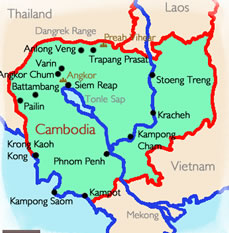
Khmer
Khmer, also known as Cambodian, belongs to the Mon-Khmer branch of the Austroasiatic language family. It is the second most widely spoken Austroasiatic language after Vietnamese. It is spoken as a first language by 13 million people and as a second language by another 1 million people in Cambodia (Ethnologue). Additionally, it is spoken by over 1 million people in Vietnam and another 1 million people in Thailand. There are relatively large expatriot Khmer communities in Canada, China, France, Laos, USA. It is estimated that the total number of Khmer speakers in the world is around 15 million. 
- Pre-Angkorian Khmer is known only from a few words and phrases in Sanskrit texts.
- Old (Angkorian) Khmer spoken in the Khmer Empire (9-13 centuries) is found in many sources and is relatively well studied.
- Middle Khmer (14-18 centuries) was a period of great linguistic change and borrowing of vocabulary from Thai, Lao, and Vietnamese. It was a period of a gradual transformation of Old Khmer into the modern form of the language.
Status
As the official language of the Kingdom of Cambodia, Khmer is used in the media, government administration, at all levels of education, and in most informal and formal contexts.
Dialects
Khmer has three main dialects that form a continuum running from north to south:
- Standard Khmer spoken by more educated people in larger cities like Phnom Penh and Siem Reap. It is mutually intelligible with the other dialects, but not all dialects are mutually intelligible among themselves.
- Surin or Northern Khmer spoken in eastern Thailand which is thought to have separated from Standard Khmer in the past few centuries
- Cardamon or Western Khmer spoken in southwestern Cambodia.
Structure
Sound system
Kmer is an extremely vowel-rich language which does not employ tones, unlike some of its Southeast Asian neighbors. Vowels Khmer has seventeen vowel phonemes, i.e., sounds that can make a difference in word meaning. Seven vowels can be either short or long, two vowels /ɛ/ and /ɔ/ are only long, and one vowel /ɐ/ is only short. In addition, there are three short and nine long diphthongs. This makes for a total of 31 possible vowel nuclei. In the table below, vowel length is indicated by a macron over the vowel.
| Close |
i, ī
|
ɨ, ɨ̄
|
u, ū
|
| Close-mid |
e, ē
|
o, ō
|
|
| Mid |
ə ə̄
|
||
| Open-mid |
ɛ̄
|
ɔ̄
|
|
| Near-open |
ɐ
|
||
| Open |
a, ā
|
- /ɛ/ = e in bed
- /ɨ/ = e in roses
- /ə/ = a in about
- /ɐ/ similar to u in plus
- /ɔ/ = o in bog
Consonants
Khmer has 17-21 consonants, depending on the dialect. Consonant clusters are allowed at the beginning, but not at the end of words. Not all consonants can occur in word-final position. There is a three-way contrast between plain, aspirated, and implosive stops. Aspiration in marked by a raised /ʰ/.
| Labio-dental | |||||||
|---|---|---|---|---|---|---|---|
| Stops | plain |
p
|
x |
t
|
c
|
k
|
ʔ
|
| aspirated |
pʰ
|
x |
tʰ
|
cʰ
|
kʰ
|
x | |
| Stops | implosive |
ɓ
|
ɗ
|
||||
| Fricatives |
s
|
h
|
|||||
| Nasals |
m
|
x |
n
|
ɲ
|
ŋ
|
x | |
| Laterals | x |
l
|
x | ||||
| Tap | xx | x |
r
|
x | x | x | |
| Semi-vowels |
ʋ
|
.xx |
j
|
||||
- /ʔ/ = sound between the vowels in uh-oh
- /pʰ, tʰ, cʰ, kʰ / are aspirated consonants released with a strong puff of air
- /ɓ/ and /ɗ/ are pronounced with the vocal cords pressed together resulting in an implosive sound when the closure is released.
- /c/ has no equivalent in English
- /ɲ/ = first n in canyon
- /ŋ/ = ng in sing
- /ʋ/ has no equivalent in English
- /j/ = y in yet
Stress
Stress normally falls on the final syllable of the word.
Grammar
Like other Austroasiatic languages, Khmer is an analytic language, i.e., it does not use inflections to express grammatical relations. Instead, grammatical relations are signaled by word order and by various particles. Nouns Khmer nouns are not marked for number, gender, or case. Number can be inferred from context, through the use of particles, numerals, or by reduplication. Gender is also unmarked, but distinctions can be made by using such words as “son”, “daughter”, “male”, and “female”. Pronouns The pronominal system of Khmer is quite complex and includes many honorific variations that are sensitive to the relative status of the interlocutors, such as their age, perceived status, as well as to levels of intimacy. Verbs Verbs are not marked for person, number, tense, aspect, or mood. Tense and aspect can be shown by particles and adverbs or understood through context. Social registers Khmer employs a system of registers which include those used for informal speech, polite speech, speaking to or about royals, and speaking to or about monks. Each register uses different verbs, names of body parts, and pronouns. Below is an example from Wikipedia, showing the different forms of the verb “to eat” across five different social registers.
|
between intimates or in reference to animals
|
polite reference to commoners
|
reference to those of higher social status
|
reference to monks
|
reference to royalty
|
|---|---|---|---|---|
|
sii
|
ɲam
|
pisa or tɔtuəl tiən
|
cʰan
|
saoj
|
Word order
The normal word order in Khmer is Subject – Verb – Object. Modifiers typically follow nouns.
Vocabulary
Modern Khmer typically derives new words by means of prefixes, infixes, and reduplication. In the past, the language has borrowed many words from Sankrit. With the advent of Theravada Buddhism at the beginning of the 15th century, Khmer began to borrow Pali words. However, as a consequence of Khmer nationalism that emerged in the 1960s, there was a movement to expunge Sankrit and Pali words from the lexicon. During the period of French domination, many French words were borrowed into the language and have become a part of both the spoken language and of technical terminology. Colloquial Khmer also has some Chinese and Vietnamese loanwords.
| Hello | cum riep sue (greeting to a man); baat cum riep sue (response by a man) cum riep sue look qum (greeting to an older person); baat cum riep sue (response by an older person) cum riep sue (greeting to a woman); caa cum riep sue (response by a woman) |
| Good bye | joom-reap leah |
| Thank you | qaa-kun |
| Excuse me | soum tooh |
| Please | suom mehta |
| Yes | baat |
| No | deh |
| Man | borsa mneak |
| Woman | srti mneak |
Below are Khmer numerals 1-10 in romanization and in Khmer script. ប្រាំ
|
1
|
2
|
3
|
4
|
5
|
6
|
7
|
8
|
9
|
10
|
|---|---|---|---|---|---|---|---|---|---|
|
muəj
|
pir
|
bəi
|
buən
|
pram
|
pram muəj
|
pram pii:
|
pram bəi
|
pram buən
|
dap
|
Writing
The Khmer script is based on a variant of the Brahmi script used to write Sanskrit, Hindi, and other Indo-Aryan languages. The Khmer script has symbols for thirty-three consonants, twenty-four dependent vowels, twelve independent vowels, and several diacritic symbols. It is a syllabic alphabet in which each consonant has two forms, one with an inherent vowel /a/ (first series) and one with an inherent vowel /o/ (second series). Vowels are indicated by using either separate letters or diacritics written above, below, in front of, after, or around the consonants. The pronunciation of the vowels depends on whether a consonant they are attached to belongs to the first or the second series. All consonants have a subscript form that is used to write the second consonant of a cluster. There are no spaces between words in Khmer. Spaces are used to indicate the end of a clause or sentence (SEAsite, Northern Illinois University). Although some efforts have been made to standardize Khmer spelling, there are inconsistencies in the spelling of many words. In addition, the romanization of Khmer is often done on an ad hoc basis. The International Phonetic Alphabet is sometimes used to transcribe Khmer, based either on their pronunciation or on their Khmer spelling. Since pronunciation can vary from one dialect to another, the resulting transcriptions may be quite misleading. Take a look at Article 1 of the Universal Declaration of Human Rights in Khmer.
| មាត្រា ១ មនុស្សទាំងអស់ កើតមកមានសេរីភាព និងសមភាព ក្នុងផ្នែកសេចក្ដីថ្លៃថ្នូរនិងសិទ្ធិ។ មនុស្ស មានវិចារណញ្ញាណនិងសតិសម្បជញ្ញៈជាប់ពីកំណើត ហើយគប្បីប្រព្រឹត្ដចំពោះគ្នាទៅវិញទៅមក ក្នុង ស្មារតីភាតរភាពជាបងប្អូន។ |
| All human beings are born free and equal in dignity and rights. They are endowed with reason and conscience and should act towards one another in a spirit of brotherhood. |
Difficulty
 How difficult is it to learn Khmer? Khmer is considered to be a Category II language in terms of difficulty for speakers of English.
How difficult is it to learn Khmer? Khmer is considered to be a Category II language in terms of difficulty for speakers of English.